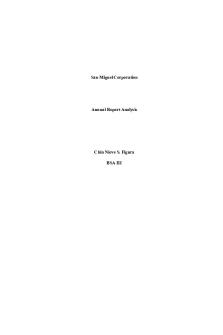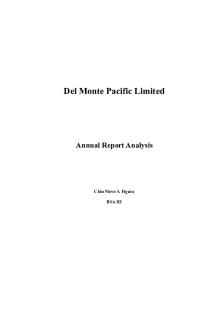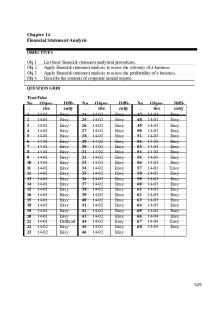Financial analysis 8 - IA 2 PDF

| Title | Financial analysis 8 - IA 2 |
|---|---|
| Author | NICH Niich |
| Course | Management Accounting |
| Institution | Misamis University |
| Pages | 10 |
| File Size | 306.2 KB |
| File Type | |
| Total Downloads | 64 |
| Total Views | 142 |
Summary
IA 2...
Description
ABS-CBN HOLDINGS CORPORATION Financial Statement Analysis
CHIN NIEVE S. FIGURA BSA-III
Disclaimer This analysis is limited only to Liabilities and Equity section of the company. It does not include asset section and it does not reflect the whole performance of the company.
Introduction The Company ABS-CBN Holdings Corporation was incorporated in the Philippines on March 30, 1999, for the primary purpose of investing, purchasing and holding real and personal properties, including, but not limited to, shares of stock, bonds, debentures, and notes, evidences of indebtedness or other securities or obligations. ABS-CBN Corporation is the Philippines' leading media and entertainment organization. It is primarily involved in content creation and production for television, online, and over-the-top platforms, cable, satellite, cinema, live events, and radio for domestic and international markets. The Company does not conduct any business other than in connection with the issuance of Philippine Deposit Receipts (PDRs), the performance of obligations under the PDRs and the acquisition and holding of shares of ABS-CBN Corporation in respect of PDRs issued. Dividends received from ABS-CBN, exercise fees and interest incomes are distributed to PDR holders less operating expenses incurred and to be incurred. In the event that the dividends received, exercise fees and interest income are no longer enough to cover the expenses; the Company is reimbursed by the PDR holders. ABS-CBN also operates various platforms including domestic television, radio networks, worldwide OTT, and online platforms. It also has interests in cable, satellite, and broadband systems in the Philippines, as well as in music and music publishing, consumer products and licensing, multimedia services, magazine and book publishing, production and post production services, telecommunication services, money remittance, cargo forwarding, TV shopping services, food and restaurant services, theme park development and management, property management, and cinema management. Summary of analysis
The financial statement of ABS-CBN is well-organized and presented fairly. The institution will continue to operate in the near foreseeable future exception stipulated by the law.
Background of the Analyzes Trade and Other Payables Trade: PDR holders Related parties (see Note 10) Unearned revenue Due to a related party (see Note 10) Accruals for: Maintenance fees Legal and professional fees Others (see Note 1 0) Statutory payables Others
478,122 155,355 8,351,598 3,427,193 680,884 192,700 311,407 3,494 74,383
575,378 144,1 56 122,157 253 12,915
Trade payables include dividends payable to PDR holders that were not yet claimed as of financial reporting date. These are noninterest-bearing and are payable on demand. Unearned revenue represents any cash dividend or other cash distributions distributed in respect of ABS-CBN shares withheld by the Company to be applied against operating expenses for the current and preceding years. Due to a related party consist mainly of noninterest-bearing advances for working capital requirements and administrative expenses from ABS-CBN, an entity under common ultimate ownership with the Company. Financial Liabilities A financial liability is derecognized when the obligation under the liability is discharged or cancelled or expires. When an existing financial liability is replaced by another from the same lender on substantially different terms, or the terms of an existing liability are substantially modified, such an exchange or modification is treated as a derecognition of the original liability and the recognition of a new liability, and the difference in the respective carrying amounts is recognized in the statement of comprehensive income. Other Financial Liabilities. Other financial liabilities are classified in this category if these are not held for trading or not designated as at FVPL upon the inception of the liability. These include liabilities arising from operations or borrowings. Loans and borrowings are initially recognized at fair value of the consideration received, less directly attributable transaction costs. After initial recognition, loans and borrowings are
subsequently measured at amortized cost using the effective interest rate method. Amortized cost is calculated by taking into account any related issue costs, discount or premium. Gains and losses are recognized in the statement of comprehensive income when the liabilities are derecognized, as well as through the amortization process. The Company's trade and other payables are classified under this category as at December 3 1, 2017. Fair value information on trade and other payables are disclosed in Note 12. Recognition of Deferred Tax Assets The carrying amount of the Company's deferred tax assets is reviewed at each reporting date and reduced to the extent that it is no longer probable that sufficient future taxable profit will be available to allow all or part of the deferred tax assets to be utilized. However, there is no assurance that sufficient future taxable profit will be generated against which all or part of deferred tax assets can be applied. Unrecognized deferred tax assets on NOLCO amounted to P4,491 ,933 and December 3 1, 2018 and 2017, respectively (see Note 9).
as at
Fair Value of Financial Instruments The Company's principal financial instruments consist of cash and cash equivalents, receivables, deposits and trade and other payables (excluding statutory payables). The following methods and assumptions were used to estimate the fair value of each class of financial instrument for which it is practicable to estimate such value: Other Financial Liabilities Trade Payables and Other Payables. Due to the short-term nature of transactions, the fair values approximate the carrying amounts as at reporting date. Equity 2018
2017
Authorized – P100 par value
Number of Shares 1,000
Subscribed, net of subscriptions receivable ofP30,OOO 400
Number of Amount Shares PIOO,OOO I ,OOO
Amount PIOO,OOO
PIO,OOO
PI O,OOO
400
The Company was incorporated in the Philippines on March 30, 1999 as "Worldtech Holdings Corporation". On September 16, 1999, the Philippine Securities and Exchange Commission approved the change in the Company's corporate name to "ABS-CBN Holdings Corporation".
Corporate Name
Date of Approval
Authorized Capital Stock
Issue/ Offer
Worldtech Holdings Corporation ABS-CBN Holdings Corporation
March 30, 1999
1,000
Price PI .00
September 16, 1999
As at December 3 1, 2018 and 2017, the total number of shareholders is eight (8). As at December 3 1, 2018 and 2017, the total number of PDR holders, which includes Philippine Central Depository Nominee Corporation, is 128 and 124, respectively. Earnings per Share The following table presents information necessary to calculate earnings per share: 2018 Net income Divide by weighted outstanding Basic/diluted earnings per share
average
2017 P_
2016
shares 400 P_
400
400
The Company has no dilutive potential common shares outstanding; therefore, basic EPS is the same as diluted EPS. Basic/Diluted Earnings per Share Basic/diluted earnings per share amounts are calculated by dividing the net income for the year attributable to shareholders by the weighted average number of common shares outstanding during the year. Capital stock is measured at par value for all shares issued. Incremental costs incurred directly attributable to the issuance of new shares are shown in equity as a deduction from proceeds, net of tax. Proceeds and/or fair value of considerations received in excess of par value, if any, are recognized as additional paid-in capital. Deficit represents the accumulated losses as of reporting date.
Statement of the Problem(s) This analysis is an attempt at identifying all the liabilities and equities of this company. Specifically, this analysis seeks answers to the following questions:
1. What are the liabilities of the company and its nature, recognition and measurement for both initial and subsequent? 2. What type of share is being issued by the company? 3. What are the transactions that changes retained earnings? 4. How do the retained earnings move within a year? 5. How do earnings per share and diluted earnings per share help the company?
Objectives in Analyzing the Case This case analysis aims to accomplish the following objectives:
To identify all liabilities and equity section of this company To analyze each nature, recognition and measurement To determine the transactions that changes retained earnings
Analysis of the Problem After analyzing the financial statements of ABS-CBN Holdings Corporation (the Company), which comprise the statements of financial position as at December 31, 2018 and 2017, and the statements of income, statements of comprehensive income, statements of changes in equity and statements of cash flows for each of the three years in the period ended December 31, 2018, and notes to the financial statements, including a summary of significant accounting policies. The accompanying financial statements present fairly, in all material respects, the financial position of the Company as at December 31, 2018 and 2017, and its financial performance and its cash flows for each of the three years in the period ended December 31, 2018 in accordance with Philippine Financial Reporting Standards (PFRSs). The independent auditor conducted audits in accordance with Philippine Standards on Auditing (PSAs). Their responsibilities under those standards are further described in the Auditor's Responsibilities for the Audit of the Financial Statements section of their report. They are independent of the Company in accordance with the Code of Ethics for Professional Accountants in the Philippines (Code of Ethics) together with the ethical requirements that are relevant to their audit of the financial statements in the Philippines, and the auditors have fulfilled their other ethical responsibilities in accordance with these requirements and the Code of Ethics. I believe that the audit evidence they have obtained is sufficient and appropriate to provide a basis for their opinion. STATEMENTS OF FINANCIAL POSITION December 31 2018
2017
Current Assets Cash and cash equivalents (Notes 5, Il and 12) Receivables (Notes Il and 12) Deposits (Notes 1 1 and 12) Prepaid tax (Note 2)
1,085 10,000
TOTAL ASSETS
P18 863 784
P14,802 132
Equity Capital (Note 7) Additional paid-in capital Deficit Net E i
10,000 23 099 35
10,000 23,099 356
TOTAL LIABILITIES AND EQUITY
P18 863 784
802 132
1,085
LIABLITŒS AND EQUITY Current Liabilities Trade and other payables (Notes 6, 10, 11 and 12)
See accompanying Notes to Financial Statements.
STATEMENTS OF COMPREHENSIVE INCOME Years Ended December 31
Exercise fees (Note 4) Interest income (Note 5)
4,123,648 OPERATING EXPENSES (Notes 4 and 8) 4,123,648 INCOME BEFORE INCOME TAX PROVISION FOR INCOME TAX (Note 9) NET INCOME/ TOTAL COMPREHENSIVE INCOME
See accompanying Notes to Financial Statement
485,150 17,596
107,820 40,651
501,610 98,056
STATEMENTS OF CHANGES IN EQUITY Years Ended December 31 2018 PIO,ooo
2017 PIO,OOO
CAPITAL STOCK (Note 7) ADDITIONAL PAID-IN CAPITAL DEFICIT
Alternatives Since, ABS-CBN’s financial statements presented fairly, the company must maintain it. It must have true and fair view in auditing which means that the financial statements are free from material misstatements and faithfully represent the financial performance and position of the entity. True suggests that the financial statements are factually correct and have been prepared according to applicable reporting framework such as the IFRS and they do not contain any material misstatements that may mislead the users. Misstatements may result from material errors or omissions of transactions & balances in the financial statements. Fair implies that the financial statements present the information faithfully without any element of bias and they reflect the economic substance of transactions rather than just their legal form. Preparation of true and fair financial statements has been expressly recognized as one of the responsibilities of the directors of companies in the corporate law of several countries. Auditors must therefore consider whether directors have fulfilled their responsibility for the preparation of true and fair financial statements when providing an audit opinion. Company law of certain jurisdictions require the auditors to expressly state in their audit report whether in their opinion the financial statements present a true and fair view of the financial performance and position of the entity. Moreover, capital risk management can be used again. As discussed in Note l, the Company has not conducted any business other than in connection with the issuance of PDRs, the performance of obligations under the PDRs and the acquisition and holding of shares of ABS-CBN in respect of PDRs issued. Capital includes capital stock, additional paid-in capital and deficit. The Company adopts a prudent approach on capital management to ensure that it maintains its net assets. Dividends received from ABS-CBN, exercise fees and the related interests are distributed to PDR holders less operating expenses incurred. Any excess over the interest distribution to PDR holders and actual operating expenses is deferred and amortized when applied to the actual operating expenses of the succeeding years. On the other hand, if the balance of the unearned revenue, exercise fees and the interest income earned during the year is not enough to cover the actual operating expenses for the year, the expenses are reimbursed from the PDR holders. The Company manages its capital structure and makes adjustments to it, in light of changes in economic conditions. To maintain or adjust the capital structure, the Company may adjust the dividend payment to shareholders. No changes were made in the objectives, policies
or processes during the years ended December 31, 2018 and 2017. The Company is not subject to any externally imposed capital requirement. As at December 3 1, 2018 and 2017, the Company considers its total paid-in capital of as capital.
Evaluation of the Alternatives As most of the companies experienced capital risk, it is crucial to give focus on this. Capital risk is the possibility that an entity will lose money from an investment of capital. It can manifest as market risk where the prices of assets move unfavorably, or when a business invests in a project that turns out to be a dud. Capital risk management is the best alternative action for this. Capital risk management is an assessment of a firm’s ability to withstand the impact of credit, market and other risks it is exposed to. On the other hand, code of ethics is more important, it sets out an organization’s ethical guidelines and best practices to follow for honesty, integrity, and professionalism. In addition, it clearly lays out the rules for behavior and provides the groundwork for a preemptive warning.
Recommendation Overall, I recommend strict abiding of code of ethics because it provides a framework and a standard for ethical decision making within the organization. Also, the independent auditors of the Company are doing their jobs in accordance with the Code of Ethics for Professional Accountants in the Philippines (Code of Ethics) together with the ethical requirements that are relevant to their audit of the financial statements in the Philippines The Code recognizes that the objectives of the profession are to work to the highest standards of professionalism, to attain the highest levels of performance and generally to meet the public interest requirement set out above. These objectives require four basic needs to be met:
Credibility In the whole of society there is a need for credibility in information and information systems.
Professionalism There is a need for individuals who can be clearly identified by clients, employers and other interested parties as professional persons in the accountancy field.
Quality of Services There is a need for assurance that all services obtained from a professional accountant are carried out to the highest standards of performance.
Confidence Users of the services of professional accountants should be able to feel confident that there exists a framework of professional ethics which governs the provision of those services.
References https://www.lifehack.org/296492/7-simple-steps-improve-your-financial-management-skills https://www.prc.gov.ph/uploaded/documents/Board%20of%20Accountancy-CE.pdf https://accounting-simplified.com/audit/concepts/true-and-fair-view https://www.capitalrm.co.uk/...
Similar Free PDFs

Financial analysis 8 - IA 2
- 10 Pages

Financial analysis 2 - IA 2
- 25 Pages

Financial analysis 7 - IA 2
- 28 Pages

Chapter 2- Financial Analysis
- 53 Pages

ia finals 1 and 2
- 19 Pages

Financial Analysis Final Paper
- 22 Pages

Ch14 Financial Statement Analysis
- 52 Pages

001 Financial Statements Analysis
- 50 Pages

Financial statements analysis
- 74 Pages

financial statemnt analysis
- 19 Pages

UBER Technologies Financial Analysis
- 14 Pages
Popular Institutions
- Tinajero National High School - Annex
- Politeknik Caltex Riau
- Yokohama City University
- SGT University
- University of Al-Qadisiyah
- Divine Word College of Vigan
- Techniek College Rotterdam
- Universidade de Santiago
- Universiti Teknologi MARA Cawangan Johor Kampus Pasir Gudang
- Poltekkes Kemenkes Yogyakarta
- Baguio City National High School
- Colegio san marcos
- preparatoria uno
- Centro de Bachillerato Tecnológico Industrial y de Servicios No. 107
- Dalian Maritime University
- Quang Trung Secondary School
- Colegio Tecnológico en Informática
- Corporación Regional de Educación Superior
- Grupo CEDVA
- Dar Al Uloom University
- Centro de Estudios Preuniversitarios de la Universidad Nacional de Ingeniería
- 上智大学
- Aakash International School, Nuna Majara
- San Felipe Neri Catholic School
- Kang Chiao International School - New Taipei City
- Misamis Occidental National High School
- Institución Educativa Escuela Normal Juan Ladrilleros
- Kolehiyo ng Pantukan
- Batanes State College
- Instituto Continental
- Sekolah Menengah Kejuruan Kesehatan Kaltara (Tarakan)
- Colegio de La Inmaculada Concepcion - Cebu




